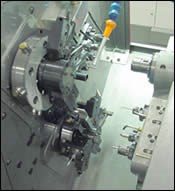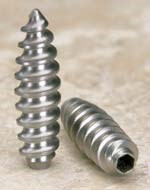Medical Machining: Speed And Accuracy Win Orders
To handle the steady flow of incoming orders, this company has prepared itself by building facilities and purchasing equipment that are able to complete its jobs quickly and efficiently.
Structure Medical, Inc. (Naples, Florida) specializes in manufacturing complex intricate parts to exacting tolerances. This includes micro-machining and multi-axis milling and turning, from prototype quantities to high volumes. The company produces finished or almost finished parts from barstock, typically in one setup.
According to Len Saiser, founder and CEO, the medical industry is extremely busy. Therefore, to handle the steady flow of incoming orders, Structure has prepared itself by building facilities and purchasing equipment that are able to complete its jobs quickly and efficiently.
The company, founded in 2004, primarily machines titanium in two facilities: a 22,000 square-foot manufacturing facility; and a 17,000-square-foot facility with administrative offices, a design area, a 7,000-square-foot machining floor with five-axis milling and Swiss-type machines plus a dedicated quality assurance and programming department.
Structure has built a "lights-out" manufacturing model for production of medical implant devices that competes with low-cost producers—an approach that makes the company unique.
"We found that most of the orthopedic device manufacturers are using the same technology they were using 20 years ago," Mr. Zaiser says. "When some suppliers seek to earn an outsourced job from those companies, they tend to emulate the manufacturing systems and protocol they see in the manufacturers' plants. We do not. As an OEM supplier to those companies, we look into the future and think about the best process based on available technology."
Its investment in turning machines by Traub (Noblesville, Indiana) is significant: Two TNL 12/7- 13/16-mm Swiss-type turning and milling centers with whirling heads mounted on the turret permit 9 hours of continuous unattended bone screw thread whirling. A TNL 26/36 32-mm Swiss-type turning and milling center provide similar capabilities. The Traub multi-axis turning machines—including main and subspindles, two turrets and two slides, permit upwards of four tools in the cut at the same time, providing cycle time savings.
The company also operates three TNK 36 turning and milling centers and two TNL 12K fixed headstock turning and milling centers, all purchased over the last few years from Traub. "By investing in multi-axis machinery and coupling it with more than 50 years of management experience creating high tolerance parts for the Department of Defense, NASA and an oxygen regulator industry, we have developed a medical manufacturing business that delivers manufacturing quality at costs comparable to off-shore manufacturers," Mr. Zaiser explains.
Structure, as a precision job shop, starts a job with a drawing from a customer with a tight tolerance part in diameter and geometry of ± 0.001. "This is not too bad, but we required a machine that could achieve those tolerances consistently without having to rely on machine offsets," says Kevin Confoy, general manager. "The Traubs were a good choice because they exhibit the required accuracy and can do complex milling that other, less rigid machines cannot."
Bone screws are a major item that the company manufactures, producing thousands every year. Made of titanium, each of these screws must be machined precisely to tolerance with no burrs or rough edges. Often in the 2-mm diameter range, screws are produced in a variety of lengths in typical lot sizes of 150 to 500 parts.
"For long screws, we use the Swiss-style machine. Most of our business, however, is the production of spine and wrist plates. For these parts, we use another machine," Mr. Confoy explains.
On several of the machines, Structure ordered thread-whirling attachments in order to achieve the tight specifications bone screws require—no burrs and tolerances in microns. "Thread whirling permits extremely long threads to be produced in tough material on very small diameters without the need to support the part, and threads can be cut into solid material without the need to pre-turn," Zaiser says.
The accessory tool for external thread whirling consists of a thread-whirling head with several carbide cutting inserts. The whirling head can be mounted on the turret or in the endworking carrier. To produce a specific thread profile, a cutting tool form is calculated and produced for that thread. On the machine, the head is positioned directly at the guide bushing and is tilted to match the desired lead angle of the thread. When cutting, only one carbide cutting edge is engaged at a time. The whirling head runs at a high rpm, and the spindle (the C axis) determines the feed rate that generates the thread lead.
Self-tapping bone screws produced by the company include threads made with these thread-whirling attachments. The titanium bar is fed into the attachment, and there is no need to first turn the bar down to the major diameter of the thread. "This saves processing time and provides a clean thread," Mr. Confoy explains.
Most conventional thread machining uses single-point tools, and typically the tool bearing on the small part will push it away, resulting in out-of-round parts. However, whirled threading avoids this.
Take a 150-piece order with 30 different sizes, for example. "The parts we machined required very little post-processing, and in fact, we did not have to tumble it. We found we can take the parts off the machine, make sure there were no broken threads on the self-tapping feature and ship them, knowing that the threads were good," Mr. Confoy says. This saved 2-3 minutes per piece, which is what it would take for an operator to inspect each self-tapping screw under a microscope.
"The time savings because of thread whirling, one setup and part quality meant that we could ship our orders 6 weeks faster," Mr. Confoy reports.
A related item, a piece of a titanium back plate, is a 1/4-inch chip that prevents bone screws from backing out once installed. Only a few thousandths thick, it is produced on one of the machines in a single operation.
"Handling the part more than once introduces the possibility of error, and secondaries require operator attendance," Mr. Confoy says. "Our intent has always been to make parts complete in one operation. If we can do that, we will do well." Reduced labor, faster cycle times and better quality will be the result, he adds.
The company also produces titanium lumbar hooks—which aid in connecting human vertebrate to a rod for support—in one operation. The hook form requires an X, Y and Z axis to complete the entire form without secondary operations and without burrs. "The Traub was a good choice for this operation because there is a lot going on with this part," Mr. Confoy says. Using up to 18 tools, including end- and side-working end mills and drills, this machine has a 15-minute cycle time.
As for time savings, the machines' programmable guide bushing drives are a helpful feature when reducing setup time. If a guide bush is not adjustable, it would have to be set precisely for the material going through it, and barstock must be ground to a 0.002-inch tolerance. Without an adjustable guide bush, any burr on the end of the bar would prevent the bar feed from retracting easily back through and would stop the machine.
"For our purposes, the Traubs have a unique combination of features that have helped us win contracts and provide speed, rigidity and precision," Mr. Zaiser says. "The machines' twin turrets ensure fast indexing, and the construction is the most stable we have found."
Mr. Confoy adds, "We can say that the more complicated your part is, the more confident we are that we can make it better than anyone else. What is important for the customer is that we can provide them a high quality part consistently. Our customers simply give us a drawing, tell us what material to use, and we produce to print."
Related Content
Automation Breakthroughs Revolutionize Precision Machining for Complex Parts
Marubeni Citizen-Cincom delivers custom solutions to address some of the biggest challenges in precision machining from handling small parts, to robot integration and unique tooling needs.
Read MoreKeeping Watch on Small Parts
From watch parts to exotic medical applications, this shop takes on the world of micromachining.
Read MoreDoes a Scanning Probe Make Sense on a Swiss-Type?
Swiss-types have limited tooling capacity, but there can be advantages to giving up some of that capacity to take advantage of a touch probe — in fact, a scanning probe — to enable in-process part measurements.
Read MoreInside the Premium Machine Shop Making Fasteners
AMPG can’t help but take risks — its management doesn’t know how to run machines. But these risks have enabled it to become a runaway success in its market.
Read MoreRead Next
How To (Better) Make a Micrometer
How does an inspection equipment manufacturer organize its factory floor? Join us as we explore the continuous improvement strategies and culture shifts The L.S. Starrett Co. is implementing across the over 500,000 square feet of its Athol, Massachusetts, headquarters.
Read MoreFinding the Right Tools for a Turning Shop
Xcelicut is a startup shop that has grown thanks to the right machines, cutting tools, grants and other resources.
Read More























